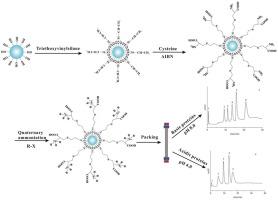Talanta ( IF 5.6 ) Pub Date : 2021-01-07 , DOI: 10.1016/j.talanta.2021.122084 Jianzhong Wang , Jianshan Wang , Xiaohui Ning , Jiawei Liu , Hongjun Xia , Guangping Wan , Quan Bai

|
In this paper, a cysteine-functionalized zwitterionic stationary phase (Cys-silica) was prepared based on the “thiol-ene” click chemistry between cysteine and vinyl-functionalized silica, and was further modified with bromoethane, 1-bromooctane and 1-bromooctadecane, respectively, to obtain a series of quaternary ammoniation-functionalized stationary phases (Cys-silica-Cn n = 2, 8 and 18). These zwitterionic stationary phases were regarded as reversed-phase/ion-exchange (RP/IEC) mixed-mode chromatography (MMC) stationary phases for protein separation. The retention behaviors of proteins on these zwitterionic stationary phases were carefully investigated. The results indicated that the retentions of acidic and basic proteins on these zwitterinonic stationary phases were significantly influenced by the acetonitrile and salt concentrations, pH of mobile phase as well as the hydrophobicity of the ligand. The separation selectivity of proteins on these zwitterionic stationary phases strongly depended on the pH value of mobile phase. The baseline separation of 6 kinds of basic proteins can be achieved at pH 8.0 using Cys-silica-C2 or Cys-silica-C8 column, and 5 kinds of acidic proteins can also be separated completely at pH 4.0 with Cys-silica-C2 column. Moreover, owing to the quaternary ammoniation-functionalization on Cys-silica by using appropriately hydrophobic bromoalkanes, the selectivity and separation efficiency of proteins can be enhanced greatly. As a result, the acidic and basic proteins can be separated completely step by step from the complex sample by adjusting pH of mobile phase using a single Cys-silica-C2 column, which illustrates that the cysteine-functionalized zwitterionic stationary phase has a great potential for protein separation.
中文翻译:

使用RPLC / IEC混合模式色谱法通过季铵化功能化的半胱氨酸-两性离子固定相进行pH依赖性的酸性和碱性蛋白质的选择性分离
本文基于半胱氨酸与乙烯基官能化二氧化硅之间的“硫醇-烯”点击化学制备了半胱氨酸官能化两性离子固定相(Cys-二氧化硅),并进一步用溴乙烷,1-溴辛烷和1-溴十八烷进行了改性。分别获得一系列季铵化官能化固定相(Cys-silica-C nn = 2、8和18)。这些两性离子固定相被视为用于蛋白质分离的反相/离子交换(RP / IEC)混合模式色谱(MMC)固定相。仔细研究了蛋白质在这些两性离子固定相上的保留行为。结果表明,酸性和碱性蛋白质在这些两性离子固定相上的保留受到乙腈和盐浓度,流动相的pH以及配体的疏水性的显着影响。这些两性离子固定相上蛋白质的分离选择性很大程度上取决于流动相的pH值。使用Cys-silica-C2或Cys-silica-C8色谱柱可在pH 8.0下实现6种碱性蛋白的基线分离,用Cys-silica-C2色谱柱可在pH 4.0时完全分离5种酸性蛋白质。此外,由于通过使用适当的疏水性溴代烷烃在Cys二氧化硅上进行季铵化功能化,可以大大提高蛋白质的选择性和分离效率。结果,通过使用单个Cys-silica-C2色谱柱调节流动相的pH,可以从复杂样品中逐步分离酸性和碱性蛋白质,这说明半胱氨酸官能化的两性离子固定相具有巨大的潜力用于蛋白质分离。











































 京公网安备 11010802027423号
京公网安备 11010802027423号